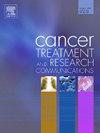Targeted therapy for non-small cell lung cancer (NSCLC) in a real-world setting: A single practice experience
IF 2.4
Q3 Medicine
引用次数: 0
Abstract
Targeted treatment of non-small cell lung cancer (NSCLC) with driver aberrations has drastically improved the outcome of a subset of patients. However, for successful adaptation in the clinical routine, many stakeholders are involved, like comprehensive cancer centers, molecular pathology, peripheral hospitals, and oncology practices. Here, we present a single center experience in personalized treatment of lung cancer in Germany. Patients with advanced NSCLC and the need for systemic treatment after identification of a targetable driver mutation have been included in this analysis. Detection of the mutations was performed within a diagnostical network. Treatment was chosen depending on the respective driver mutation. We identified 58 patients (26 male, 32 female) with treatment relevant driver mutations: 33 patients (56.9 %) had an EGFR mutation, nine patients (15.5 %) presented with ALK translocation, five patients (8.6 %) were detected to have BRAF mutations, four had ROS1 translocations (6.9 %) and 8 patients had MET mutations (13.8 % each). In one patient, concomitant BRAF and MET amplifications were detected. 52 patients received targeted therapy. The median overall survival was 35.5 months (95 % CI, 18.0–52.9 months). 32 patients (64 %) received subsequent treatment after initiation of targeted therapy first-line. Our single-center experience demonstrates that advances in the field of targeted NSCLC therapy are quickly incorporated into clinical routine in Germany. Noteworthy, no new safety information was found.
靶向治疗非小细胞肺癌(NSCLC)在现实世界的设置:一个单一的实践经验
靶向治疗非小细胞肺癌(NSCLC)与驱动畸变显著改善了一部分患者的预后。然而,为了在临床常规中成功适应,许多利益相关者都参与其中,如综合癌症中心、分子病理学、周边医院和肿瘤实践。在此,我们介绍了德国单个中心在肺癌个性化治疗方面的经验。该分析包括晚期NSCLC患者,在发现可靶向的驱动突变后需要进行全身治疗。突变的检测是在诊断网络中进行的。根据各自的驱动突变选择治疗方法。我们确定了58例患者(26名男性,32名女性)有治疗相关的驱动突变:33例患者(56.9%)有EGFR突变,9例患者(15.5%)有ALK易位,5例患者(8.6%)被检测出有BRAF突变,4例有ROS1易位(6.9%),8例患者有MET突变(各13.8%)。在一名患者中,检测到伴随的BRAF和MET扩增。52例患者接受靶向治疗。中位总生存期为35.5个月(95% CI, 18.0-52.9个月)。32例(64%)患者在开始一线靶向治疗后接受了后续治疗。我们的单中心经验表明,靶向非小细胞肺癌治疗领域的进展在德国迅速融入临床常规。值得注意的是,没有发现新的安全信息。
本文章由计算机程序翻译,如有差异,请以英文原文为准。
求助全文
约1分钟内获得全文
求助全文
来源期刊

Cancer treatment and research communications
Medicine-Oncology
CiteScore
4.30
自引率
0.00%
发文量
148
审稿时长
56 days
期刊介绍:
Cancer Treatment and Research Communications is an international peer-reviewed publication dedicated to providing comprehensive basic, translational, and clinical oncology research. The journal is devoted to articles on detection, diagnosis, prevention, policy, and treatment of cancer and provides a global forum for the nurturing and development of future generations of oncology scientists. Cancer Treatment and Research Communications publishes comprehensive reviews and original studies describing various aspects of basic through clinical research of all tumor types. The journal also accepts clinical studies in oncology, with an emphasis on prospective early phase clinical trials. Specific areas of interest include basic, translational, and clinical research and mechanistic approaches; cancer biology; molecular carcinogenesis; genetics and genomics; stem cell and developmental biology; immunology; molecular and cellular oncology; systems biology; drug sensitivity and resistance; gene and antisense therapy; pathology, markers, and prognostic indicators; chemoprevention strategies; multimodality therapy; cancer policy; and integration of various approaches. Our mission is to be the premier source of relevant information through promoting excellence in research and facilitating the timely translation of that science to health care and clinical practice.
 求助内容:
求助内容: 应助结果提醒方式:
应助结果提醒方式:


